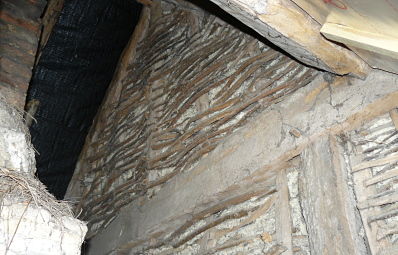 What is Wattle & Daub and how does it differ from Cob?
What is Wattle & Daub and how does it differ from Cob? Cob and daub are both very similar materials, being composed of mud and straw, but they are used in quite different ways. Cob walls are freestanding and normally two or three feet thick, whereas wattle and daub is used in panels that fill the gaps within the structure of a timber framed building. An arrangement of small timbers (wattle) form a matrix to support a mud-based filling (daub). The wattles normally comprise of primary timbers or staves, which are held fast within the frame and the secondary timbers or withies, which are nailed to, tied to, or woven around the staves. The daub is applied simultaneously from both sides in damp hand-fulls, pressed into and around the wattle to form a homogenous mass. Historically once the daub had hardened, the surface was normally lime plastered and/or lime washed.
How do I know whether to repair or replace it?Knowing whether a damaged panel should be repaired or replaced requires careful consideration. It is important to weigh up the many contributing factors such as its age, importance, rarity, position and function within the building, condition and cost. Expert advice will often be required.
How do I repair it?Repair to a panel isn't too difficult if the daub has already fallen away, providing the wattle is basically sound. Deterioration is often found where the wattle has been damp, and hazel seems particularly prone to woodworm. Wattle suffering from insect attack may need localised treatment but are often strong enough to carry the daub. Additional support, in the form of new staves, withies or timber battens, or stainless steel mesh fixed across weakened areas, may be necessary. The wattle doesn't need to be absolutely rigid, but should be strong enough to carry the daub. On occasions you may need to hold the wattle firm whilst applying the new daub. Where daub is still in place the repair is more challenging. It may be possible to re-support or re-fix loose daub using non-ferrous wire ties or screws with washers and apply new daub around it. When areas of daub have failed or become detached, they can be repaired by applying new daub to fill the missing areas (after careful preparation and pre-wetting). If you find you get excessive shrinkage it's either because there's too much suction in the existing daub or the repair mix is unsuitable. Old daub salvaged from damaged panels can be broken up and mixed with a little water to make it useable again. You may need to add additional materials to bulk it out or modify its performance. Try mixing one part of daub with one part of a good coarse lime mortar to achieve a well-behaved material. Shrinkage in daub is normal, and gaps will often appear around the edge of a panel. These gaps should be filled with daub or lime mortar. Sometimes it's necessary to remove a daub panel in one piece, while repairs are carried out to the timber frame, and then put it back in the same position. Here specialist advice is essential if a disaster is to be avoided.
How do I replace it?Before replacing any panels on a listed building, consult your local conservation officer. Listed building consent is normally necessary and you may be required to record the existing panel(s) before proceeding. It is important to understand why the old ones have failed and address the causes. There is no point in replacing a panel damaged by a leaking gutter if the leak is still there. The design of the existing panel normally dictates the pattern of the new one.
Where do I find the materials?Staves and withies are available from specialist suppliers such as Old House Store. Daub is also available, but your original daub was probably sourced locally.
Daub is generally made up of:
Binders such as clay, lime and chalk/limestone dust to hold the mix together, Aggregates such as earth, sand and crushed chalk/stone to give it bulk and dimensional stability Reinforcement such as straw, hair, flax, hay and grass to help hold it all together, control shrinkage and provide long-term flexibility.
Some locally available materials may contain more than one of the ingredients - for example, sub-soil may contain clay, sand and chalk. There are probably as many daub mixes as there are daub buildings. To make a new daub mix, try experimenting with local materials. Remember to add only enough water to make the mix workable (too much could cause excessive shrinkage). Try to mix the ingredients (without reinforcement) in advance and leave the mix to 'temper'. It can then be re-mixed and reinforcement added, which allows any dry ingredients to soak up water, giving the whole mix an even moisture content.
Wattle and daub has proved itself as a building technique. Properly maintained, panels will not only keep the weather out, but also create an environment where the structural timber frame is not at risk. Wattle and daub is not only the sound choice from a constructional point of view, but it is also the most environmentally friendly approach. The materials are renewable, from sustainable sources, and minimal energy is consumed in their production.
Ian Pritchett is the Managing Director of IJP Building Conservation Ltd. IJP sell a wide range of traditional materials, including wattle and daub, through their retail division Old House Store. (OldHouseStore.co.uk)